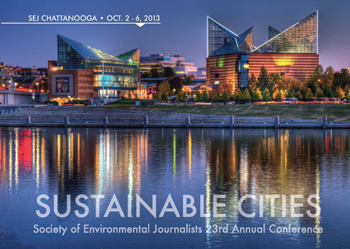Journalists are eligible for free email subscriptions to SEJournal, including TipSheet, WatchDog (on access issues) and more.
Welcome Back to Chattanooga...
Welcome Back to the Future!
| Agenda | Coverage | Lodging/Travel | Exhibits/Receptions | Environmental News | About Chattanooga |
Chattanooga is born again. Once forgotten as a smog-obscured and industrially polluted backwater, this city cradled by the Tennessee River is sought out today as a showplace of green technology and as an outdoor mecca offering a lifestyle increasingly in sync with Tennessee’s hardwood-ribboned hills, deep hollows and plains.
Professional Journalists:The deadline for fellowships applications was June 24th. |
Part of Chattanooga’s draw for creative young people and ecofriendlier industries is the city’s own state-of-the-art, multi-faceted fiber optics program that includes a smart grid and fully networked energy-saving street lights that can double as air monitors, surveillance, spotlights and emergency alerts.
Sustainability is a byword here, but just how sustainable can a city be? And what are the best practices? That’s what this conference is all about, and in Chattanooga, we’ll show you efforts aimed at that high standard.
You’ll view robotics in the tightly controlled Volkswagen factory that incorporates cutting-edge technology to reduce emissions and waste and keep employees healthy. This world’s first platinum-LEEDcertified auto assembly plant has its own solar farm that generates 12 percent of VW’s power-hungry manufacturing needs.
You will experience within a day’s reach of most of the Southeast and a couple of hours from major airline hubs, such as Atlanta, an amalgam of some of the world’s richest biodiversity, thorniest energy issues, and warmest down-home hospitality. And, you’ll return home with solid new sources and sure-fire ideas for stories that will stoke editors and readers alike.
The central location — with the Appalachian Mountains and the Tennessee Valley Authority headquarters nearby – will allow trips to a nuclear plant, hydroelectric dam and a landscape analysis lab on the Cumberland Plateau that is helping to save the keystone tree of the Appalachians.
Activities will include tours to:
- Snorkel the crystal-clear Conasauga River for colorful darters that live in only one place on the planet and understand the uncompromising link between wilderness areas and water health.
- Walk the giant hemlock-lined Fiery Gizzard Creek gorge of the Cumberland Plateau, which is threatened by invasives and development.
- Visit Oak Ridge, key to the Manhattan Project that yielded nuclear bombs and power, a legacy of pollution and a world-class research center today looking into climate change.
- Inspect the Sequoyah Nuclear Plant in Soddy-Daisy, 20 miles north of downtown Chattanooga, and see the site of the 2008 Kingston ash spill where TVA is in final stages of removing coal ash from 400 acres of what was once farmland and the Emory River.
- Watch a drone used in journalism fly, and talk with SEJ members working on the technology and applications in advance of FAA rules for commercial drone deployment.
We’ll also explore the world-famous Tennessee Aquarium where you traverse an Appalachian world — from the highest mountain stream to the bottom of the Tennessee River — with giant catfish, roe-producing paddlefish and a bit of old cans and debris as well.
The conference will coincide with major music and outdoor festivals — including the 3 Sisters Bluegrass Festival and River Rocks Festival — so you’ll see the fun in sustainability, too.
We welcome you to Chattanooga and to the 23rd Annual Conference of the Society of Environmental Journalists. Don’t miss it. SEJers were inspired by the Chattanooga story 15 years ago, and there’s far more to learn now.
CONFERENCE CHAIRS:
Anne Paine, recently retired from The Tennessean in Nashville;
David Sachsman, West Chair in Communication and Public Affairs, University of Tennessee at Chattanooga; and
Pam Sohn, Environment Reporter, Chattanooga Times Free Press.
- For more on Tennessee and biodiversity, see Tennessee Parks and Greenways Foundation.
- SEJ's July 5, 2012, announcement.
- "Society of Environmental Journalists Bringing Conference Back to Chattanooga," Chattanooga Times Free Press, June 24, 2012, by Kevin Hardy.
- Chattanooga Convention and Visitors Bureau.
SOCIETY OF ENVIRONMENTAL JOURNALISTS
The Society of Environmental Journalists was founded in 1990 by a small group of award-winning reporters, editors and producers from top news organizations in the United States. Today SEJ is a lively educational community of more than 1,350 print, broadcast and online journalists, along with students and educators throughout the U.S., Canada, Mexico and 27 other countries. SEJ’s mission is to strengthen the quality, reach and viability of journalism across all media to advance public understanding of environmental issues. SEJ conferences, reporting tours, regional events, publications, Freedom of Information WatchDog Program, awards, fellowships, mentoring, mini-grant programs and robust membership network have earned the organization a stellar reputation as a respected media peer group capable of informing and advancing news coverage of a wide range of environmental issues, with significant results. For more information visit www.sej.org.
THE UNIVERSITY OF TENNESSEE AT CHATTANOOGA
 The University of Tennessee at Chattanooga (UTC) has become a national model for metropolitan universities. UTC is dedicated to meeting the general and professional educational needs of area residents, known for strong community involvement and leadership, with emphases on applied research and public service. In collaboration with many regional partners, UTC offers students an experiential learning environment graced with outstanding teaching scholars in bachelor's, master's, and doctoral programs in the College of Arts and Sciences, College of Business, College of Engineering and Computer Science, and the College of Health, Education and Professional Studies. The University of Tennessee at Chattanooga is one of three universities and two other affiliated institutions in the University of Tennessee System, the others being in Knoxville and Martin. Founded in 1886, the University had been a private institution for 83 years when it joined the University of Tennessee's system of statewide campuses in 1969. UTC retains the best aspects of that private tradition, yet offers all the resources of a modern public university.
The University of Tennessee at Chattanooga (UTC) has become a national model for metropolitan universities. UTC is dedicated to meeting the general and professional educational needs of area residents, known for strong community involvement and leadership, with emphases on applied research and public service. In collaboration with many regional partners, UTC offers students an experiential learning environment graced with outstanding teaching scholars in bachelor's, master's, and doctoral programs in the College of Arts and Sciences, College of Business, College of Engineering and Computer Science, and the College of Health, Education and Professional Studies. The University of Tennessee at Chattanooga is one of three universities and two other affiliated institutions in the University of Tennessee System, the others being in Knoxville and Martin. Founded in 1886, the University had been a private institution for 83 years when it joined the University of Tennessee's system of statewide campuses in 1969. UTC retains the best aspects of that private tradition, yet offers all the resources of a modern public university.
 |
The Tennessean (Nashville)
|
Past SEJ Annual Conferences















 Advertisement
Advertisement 



